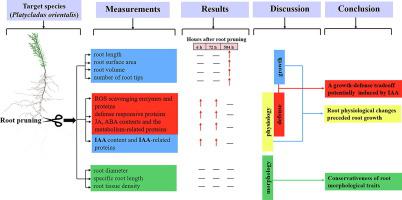Journal of Advanced Research ( IF 10.7 ) Pub Date : 2021-07-14 , DOI: 10.1016/j.jare.2021.07.005 Zhipei Feng 1 , Deliang Kong 1 , Yuhua Kong 1 , Baohong Zhang 2 , Xitian Yang 1

|
Introduction
Root pruning is commonly used to facilitate seedling transplantation for the restoration of degraded or damaged ecosystems. However, little is known about how root growth coordinates morphology, physiology and defense functions following root pruning.
Objectives
We aim to elucidate whether and how root growth trades off with defense functioning after pruning.
Methods
Seedlings of Platycladus orientalis, a tree species widely used in forest restoration, were subjected to root pruning treatment. A suite of root growth, morphological and physiological traits were measured after pruning in combination with proteomic analysis.
Results
Root growth was insensitive to pruning until at 504 h with a significant increase of 16.8%, whereas root physiology was activated rapidly after pruning. Key root morphological traits, such as root diameter, specific root length and root tissue density, showed no response to the pruning treatment. Plant defense syndromes such as reactive oxygen species-scavenging enzymes and defensive phytohormones such as jasmonic acid and abscisic acid, were recruited at six hours after pruning and recovered to the unpruned levels at 504 h. Compared with the controls, 271, 360 and 106 proteins were differentially expressed at 6, 72 and 504 h after root pruning, respectively. These proteins, associated with defense function, showed temporal patterns similar to the above defense syndromes.
Conclusion
Our results suggest a root growth-defense tradeoff following root pruning in P. orientalis. This tradeoff was potentially due to the significant increase of indole-3-acetic acid, the phytohormone stimulating root branching, which occurred soon after pruning. Together, these results provide a holistic understanding of how root growth is coordinated with root morphology, physiology, and defense in response to root pruning.
中文翻译:

侧柏根系修剪与根系形态、生理和防御功能的协调
介绍
根修剪通常用于促进幼苗移植,以恢复退化或受损的生态系统。然而,关于根系生长如何协调根系修剪后的形态、生理和防御功能知之甚少。
目标
我们旨在阐明修剪后根系生长是否以及如何与防御功能进行权衡。
方法
对广泛用于森林恢复的树种侧柏幼苗进行了剪根处理。修剪后结合蛋白质组学分析测量了一套根生长、形态和生理特征。
结果
直到504 h,根系生长对修剪不敏感,显着增加了16.8%,而修剪后根系生理迅速激活。关键的根形态特征,如根直径、特定根长度和根组织密度,对修剪处理没有反应。植物防御综合征,如活性氧清除酶和防御性植物激素,如茉莉酸和脱落酸,在修剪后 6 小时被招募,并在 504 小时恢复到未修剪的水平。与对照相比,在剪根后 6、72 和 504 h 分别有 271、360 和 106 种蛋白质差异表达。这些与防御功能相关的蛋白质显示出与上述防御综合征相似的时间模式。
结论
我们的研究结果表明,东方杨修剪根系后的根系生长-防御权衡。这种权衡可能是由于吲哚-3-乙酸的显着增加,一种刺激根分枝的植物激素,这种情况在修剪后不久就发生了。总之,这些结果提供了对根系生长如何与根系形态、生理学和防御相协调以响应根系修剪的整体理解。


























 京公网安备 11010802027423号
京公网安备 11010802027423号